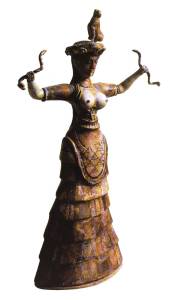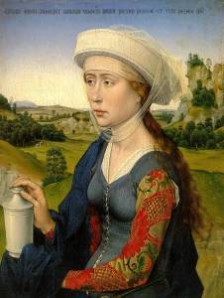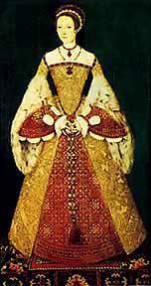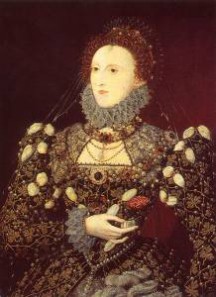Prologue
This short overview tells you about the origin and the evolution of the Corset through the past centuries up to today . Of course, that can only be done in connection with a view on the general fashion in the particular century and its relation to society. However, we can only give a short description, reduced to the absolute necessities. At all times and under every form of political or social situation, fashion created its local specialities, variations with a more or less short lifetime or special appearance in public. In short, fashion was and is much more complex than can be described here with this text. This is true especially for the 19th century, with its extremly high number of stylistic variations. Here we can give you a very rough overview of tendencies only.
You may wonder about the fact that we cannot show pictures of corsets in early times. The reason is quite simple: they do not exist! Artists did not paint their models, mostly ladies of high society, showing their underwear. Existing well-preserved or renovated original pictures with the subject 'undergarment' or 'corset' are from early 18th century. Our knowledge of corsets from those early days is based on written documents or indirect conclusions from pictures or analysis of fragments of textiles. Therefore the expression 'we know' is an exaggeration; but we can 'reasonably assume' how things may have been.
Old Times - The Ancient World

A lot of pictures and statues from that minoic period give us the strong impression that ladies used a kind of body-shaper or the waist had been laced using a different method. We do not know. The old poets, Homer for instance, had been much more interested in the weapons of the men than in the ladies underwear.
During the following Greek civilization, small-waist accentuated clothing had been in vogue, but not as tight as formerly on Crete.
The Greeks were followed by the Roman Empire as the leading force in political, military and cultural aspects around the (known) world. With their calm, purposeful and pragmatic way of life, the Romans dressed themselves with a Tunica or Toga in a simple way. However, some ladies used a kind of bra, made of strips of textile.
Later on, approximately at the time of Julius Caesar (and Asterix) the high society started to appreciate expensive pomp, but more expressed by the use of gold and jewellery than with sophisticated styles for dresses.
Knights and Courtly Love - The Middle Ages

During the gothic period (14th century), long and slim shapes had been "in" - not only for steeples but for people too. Ladies used to wear long and tight fitting clothes. Some experts speculate on very vague hints, that bandages had supported the visible slimness. That's quite reasonable, because female vanity existed at all times. However, no proven evidence is available.
At the end of the 15th century, front-laced bodices occurred, stiffened with strengthened fabric and sometimes even with wires of brass.
The First Period of Corsets - The Renaissance (16th Century)

These first corsets were made of fabrics or leather with sewed in pieces of wood or metal to create the necessary stiffness. These stiffeners had the function to support the body (not the bust) and to symbolize by its hardness and stiffness the stand-offishness of the Lady, very similar to the armour of her husband (which was more a symbol than a protection, too, because firearms were already being used). This corset-design was not meant to create a small waist or accentuated raised breasts. On the contrary, the fashion asked for "no-bust", the bust had to be pressed flat. A lady's highly stand-offishness excluded maternal curves. Matching the corset, a stiff conical hoop-skirt was in vogue. This underwear had a triple function: to display a maximum of fabric as an expression of wealth, to create a certain distance to other (lower class) people and, visually, to give the impression of an accentuated waist. It's quite sure that this fashion created some of the most uncomfortable garments women ever wanted to endure.
The Tudor fashion-style in England was very much influenced by the fashion of the Royal Court of Spain and was very similar in the elements of style. Austria, like Spain a part of the Empire of Habsburg, was influenced by the Spanish ideas of fashion, too, as well as the Netherlands. The courts in France, Germany and Italy preferred a less stiff line than the Spanish. In France people preferred obviously wide hips. They created an extra wide hoop-skirt, the so-called "panier".
In the time of late Renaissance, Elizabeth I was Queen of England. She gave the name to the fashion of the time as "Elizabethan Style", developed from the Tudor style. It was less rigorous and accentuated a small-laced waist. But the waist-reduction was not yet created by the corset itself, but by a laced bodice or by bandages.




